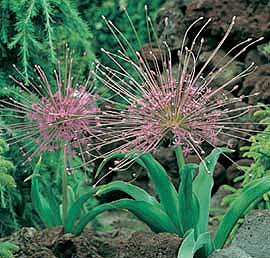Sunday, December 31, 2006
Sunday, December 24, 2006
Wednesday, December 20, 2006
New Christmas Cactus!
 Jane doesn't know it yet, but she's becoming a team member on this blog, come January. She has too many great ideas to keep quiet any longer!
Jane doesn't know it yet, but she's becoming a team member on this blog, come January. She has too many great ideas to keep quiet any longer!The Christmas tree didn't cheer me up. And, the parties have been a bore. But, a special little package from Jackson & Perkins really brightened my day. I knew it was from her before I opened it. (Soul sisters.)
Keep Christmas Cactus happy by ignoring the word 'cactus.' They prefer cool temperatures and moist soil for longest blooms. But, they cannot sit in water. Drain their saucers and wait until top soil is dry to water again.
These beauties are breathtaking for awhile but they look pretty ragged as the flowers tire out. That's a good time to cut back their sectioned leaves for stronger flowering. Propagate these leaves in moist vermiculite and they should bloom the following year.
* Schlumbergera truncata, the Christmas Cactus, feels right at home in high altitudes. It was originally a forest cactus at high (4,000+) elevations in Brazil.
* Cool nights, around 50 degrees F, get them on a blooming schedule for a bright Christmas show.
Sunday, December 17, 2006
Starting Over
 In a fit of temporary insanity, I gave away our Christmas tree.
In a fit of temporary insanity, I gave away our Christmas tree.I live in a duplex and I'm the worst excuse for a landlady you could ever imagine. Yesterday, we accidently knocked over my tenant's lovely tree and broke most of her ornaments. The kids were crying and I panicked. So, we hauled our tree over to their apartment to make amends.
As with most decisions made under duress, what seemed like a bright idea at the time now seems like the dumbest thing I've ever thought of! So, as of this morning, we're starting over ~ with a little help from our 4-legged friends.
Saturday, December 16, 2006
Spending A Dime To Save A Nickel
It all started with a hair-brained idea to hire a new repairman because the old repairman (who was very good) was very expensive. Four hours and $200 later, the gas fireplace was no closer to being fixed. And, then he knocked over my tenant's beautifully decorated Christmas tree. Perhaps it's the gravitational pull. Because, when days start spiraling downward, bad stuff accelerates rather quickly. Right then, my tenant walked in with her two little kids. They took one look at that mess and started to cry. Me, too.
Wednesday, December 13, 2006
Christmas Trees For Years To Come
 The great debate continues... what's best for the environment?
The great debate continues... what's best for the environment?Buy a fake tree? Buy a live tree?
Well, they're not exactly 'live' if they're leaning against a chain link fence in the Christmas tree lot at your local supermarket.
There is another option. Buy a real, live tree!
This afternoon, I tromped through the snow to pay a visit to our Christmas tree from 4 years ago. We bought it live and then transplanted it into the yard the following spring. This year, it's sporting a few twinkling lights.
If you opt for a truly live, potted evergreen keep it in the house for a maximum of ten days.
Set it outside, in the pot, in the shade, through the rest of the winter. (Water if there is no snow cover.)
Good Christmas trees to plant outdoors:
Norway Spruce is a popular cut Christmas tree but not so great in the garden. It drops its needles all year long.
- Korean Fir (Abies koreana ) grows to approximately 40 ft, a perfect size for most yards. USDA zones 5-7.
- Noble Fir (Abies procera) is a gorgeous silvery-blue tree with fragrant tips, though too tender for the mountains anywhere but the Pacific Northwest. USDA zones 7-10.
- Fraser Fir (Abies fraseri) has soft needles and strong boughs, ideal for heavy ornaments. USDA zones 4-7. Happiest in high altitudes.
Monday, December 11, 2006
Good Things For Body & Soul
 Art washes away from the soul
Art washes away from the soulthe dust of everyday life.
- Pablo Picasso
There’s Mapplethorpe at the Guggenheim. Ansel Adams across the street. Martinis in Moscow. Croissants in Paris, Chianti in Venice.
What you do in Vegas, stays in Vegas. Unless you're me. In that case it all gets packed in the truck for the drive back home: holiday gifts, French wines, gourmet treats and last, but not least, a rejuvenated spirit.
What you do in Vegas, stays in Vegas. Unless you're me. In that case it all gets packed in the truck for the drive back home: holiday gifts, French wines, gourmet treats and last, but not least, a rejuvenated spirit.
I have gambled, and lost, on the stock market and love. But, when this girl gets the blues, Vegas is a sure bet.
Thursday, December 07, 2006
Blue Christmas
 Six years ago I got my very first paid writing gig. I was ecstatic. I labored for days over the article and thought I was a shining star when it was approved, with no revisions. After that happened 3 months in a row, I began to suspect that the reason no one was editing the work was NOT because it was good writing. It was because the people who hired me didn't care enough to read it.
Six years ago I got my very first paid writing gig. I was ecstatic. I labored for days over the article and thought I was a shining star when it was approved, with no revisions. After that happened 3 months in a row, I began to suspect that the reason no one was editing the work was NOT because it was good writing. It was because the people who hired me didn't care enough to read it.I put my theory to the test with a holiday article entitled: It's All Norman Rockwell's Fault.
If my company's legal department had gotten their hands on this, they would have fired me on the spot. But, they didn't. Because they didn't see it. In fact, nobody bothered to proofread it and whaddyaknow, it got published. Up until blogging was invented, it was the only heartfelt piece I'd ever written.
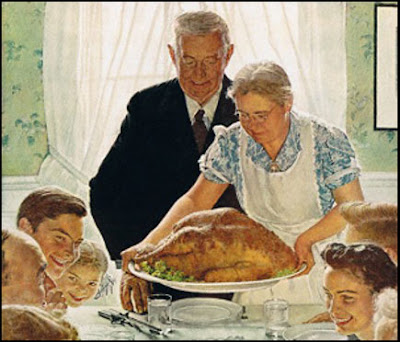 And that's because it is Norman's fault. Idealistic Norm and his happy housewife and grinning family and big, fat turkey (you know the painting I'm talking about...) If he'd never painted it, we never would have known what we were missing!
And that's because it is Norman's fault. Idealistic Norm and his happy housewife and grinning family and big, fat turkey (you know the painting I'm talking about...) If he'd never painted it, we never would have known what we were missing!From blues to bliss and back again, I have been riding an emotional roller coaster and I'm not sure why. Can it be that being an orphan is that big a deal?
All I know is... I've lost the will to attend. I've been invited to more Christmas parties this year than ever before and I'm running out of lame excuses as to why I can't go.
I'd like to call off Christmas but that, like most things in life, is beyond my control. So, I'm trying. I really am. I hauled out the ornaments and plugged in the lights. I even bought a real Christmas tree, in hopes of finding my blithe spirit. (Though so far all I've done is grumble at the price.) Stay tuned...
Friday, December 01, 2006
Poinsettia, The Christmas Plant
 If, or when, my ship comes in, I'll buy a little cottage on the island of Kauai. There, I will garden to my heart's content (instead of shoveling snow as I was doing earlier this morning.) This is what's called a pipe dream 'cause I can't even afford a parking space in Hawaii.
If, or when, my ship comes in, I'll buy a little cottage on the island of Kauai. There, I will garden to my heart's content (instead of shoveling snow as I was doing earlier this morning.) This is what's called a pipe dream 'cause I can't even afford a parking space in Hawaii.But, what is life without dreams? One of mine is to step out on the front porch of my little grass shack (in December, of course) and see a garden wildly blooming with scarlet Poinsettias. As it is, I only get to enjoy them once a year and they're not exactly wild.
 Holiday Poinsettias:
Holiday Poinsettias:Treat them kindly and they will bloom until Valentines Day. Pamper them and they can grow to be 10 feet tall.
- Take care bringing them home. Poinsettias will drop their leaves if exposed to cold temps for as little as 10 minutes.
- Remove the decorative foil, or plastic wrap, as soon as you get them home.
- Roots need to breathe and soil should be slightly dry before watering. No fertilizer required.
- Choose a cool spot with bright light for longest flowering.
* December 12th is National Poinsettia Day. Why wait? A dozen Poinsettias are cheaper than a live tree. Go nuts. :)
Friday, November 24, 2006
African Violets
 African Violets grow perfectly for 2 types of people:
African Violets grow perfectly for 2 types of people:1) Residents of Tanzania
2) Indoor Gardeners with a lot of time on their hands
If you don’t fall into those two categories, you’re probably an African Violet serial killer like me... and Sandy... and pretty much everyone else I know. Each year, supermarkets tempt us with these darling little house plants though the average life expectancy in my home is about 6 weeks.
* The quickest way to kill them is by over watering. Water when soil is dry to the touch.
 * Another good way to do a bad job is to water them from above. They absolutely hate getting their leaves wet. Set them in a saucer and let the roots soak up the water.
* Another good way to do a bad job is to water them from above. They absolutely hate getting their leaves wet. Set them in a saucer and let the roots soak up the water.East windows, with morning sunlight and bright light for the rest of the day is ideal. (My M.O. generally involved placing them in a hot, south window where they literally curled up and died.) If leaves start turning brown, the plant is getting too much light.
 Spend the extra dollar on African Violet soil. Give them diluted plant food, once a month.
Spend the extra dollar on African Violet soil. Give them diluted plant food, once a month.These little flowers grow wild in one small place on the planet, the rainforests of East Africa. Make them feel at home by creating a humid environment.
Put a layer of stones in a deep saucer, fill with water, and place your flower pot on top of it. (Pot should sit above the water level.) The water will slowly evaporate upwards, creating the perfect flowering environment for your African violet. (Which, incidently, is not a violet at all. But, that's a story for another day.)
Wednesday, November 22, 2006
Chantrelles And Other 'Shrooms
It's that time of year again. No... not Thanksgiving. No.... not time to go broke on holiday gifts. Give up? It's time to renew your subscription to the Mycological Association!
That's Sci-Fi talk for mushroom hunters. Every state in the US has a local organization that scowers for edible mushrooms. You might be surprised to discover that Utah has some of the best edible wild mushroom crops in the world.
 Including Chantrelles, a delightful delicacy with the aroma of apricots. They taste more like a flower than a mushroom. They're absolutely delectable!
Including Chantrelles, a delightful delicacy with the aroma of apricots. They taste more like a flower than a mushroom. They're absolutely delectable!Even the chefs at Café des Artistes, in Manhattan, rely on crazy mushroom people who forage mixed woods and crawl under conifers and oaks to find this tasty 'shroom. That's because Chantrelles refuse to grow in a commercial environment.
Before you pull on your boots and head to the woods, keep in mind that Chantrelle hunting is not as easy as it sounds. These mushrooms look similar to the Jack O'Lantern (Omphalotus illudens) and the False Chanterelle (Hygrophoropsis aurantiaca,) both of which are poisonous.
 Edible mushrooms commonly found in Utah:
Edible mushrooms commonly found in Utah:- Chantrelles
- Black, Yellow, and White Morels
- Shaggy Mane
- Meadow Mushroom
- Wood Ear
- Puffball
- King Bolete
* Do not, under circumstances, eat a wild mushroom unless it has been officially identified as an edible species.
** Do not, under any circumstances, believe your significant other when she says she 'knows' these mushrooms are okay. Remember Arsenic and Old Lace?
 Surprise, surprise, Black Moon knows his stuff. He wrote in, commenting about the cute little red mushroom in the top photo. The Amanita muscaria, the Fly Agaric has a sordid past, used by the Vikings prior to battle. It's loaded with toxins that can make you crazy and violently ill... But, that's not why I chose it. The Fly Agaric has been associated with Christmas ornaments and other holiday decor since 1652.
Surprise, surprise, Black Moon knows his stuff. He wrote in, commenting about the cute little red mushroom in the top photo. The Amanita muscaria, the Fly Agaric has a sordid past, used by the Vikings prior to battle. It's loaded with toxins that can make you crazy and violently ill... But, that's not why I chose it. The Fly Agaric has been associated with Christmas ornaments and other holiday decor since 1652.Saturday, November 18, 2006
Thanksgiving Sweet Potatoes
 Thanksgiving has always been my favorite holiday. I can over-indulge at someone else's house. I don't have to bring presents. And, I'm generally clever enough to get out of washing the dishes, too!
Thanksgiving has always been my favorite holiday. I can over-indulge at someone else's house. I don't have to bring presents. And, I'm generally clever enough to get out of washing the dishes, too!I'm determined to make this a good one because lately things have gone awry.
Two Thanksgivings ago, I got in a big fight with a Republican. Since then, I've had to be extra nice to her, just to keep the peace, and that pains me beyond words!
Last year, I showed up on my best behavior but I was in charge of desserts. I slaved for hours and hours and hours, but they were horrible and everyone was too nice to say so.
The forecast for this holiday is much brighter. After last year's disaster, I've been assigned the easy task of sweet potatoes.
If you've been losing sleep over the difference between yams and sweet potatoes, fret no more...!
Impress your friends by explaining that yams and sweet potatoes are entirely unrelated, though here in the US, they're essentially the same.
Yup, it's just another marketing ploy. In spite of everything your grocer tells you, you'd be hard-pressed to buy a yam in America. Yams sold in the US are just a different variety of sweet potato.
 Garnet Sweet Potatoes (marketed as yams) have deep, red skin and bright orange flesh. Moisture content is much higher, making these a great choice for candied sweet potatoes or my all time favorite, Sweet Potato Cheesecake.
Garnet Sweet Potatoes (marketed as yams) have deep, red skin and bright orange flesh. Moisture content is much higher, making these a great choice for candied sweet potatoes or my all time favorite, Sweet Potato Cheesecake.
Jersey Sweet Potatoes have tan skin and yellow flesh. They're sweeter than 'yams' and also drier. Great for muffins and breads.
Sweeten up your Garnet Reds with Dark Brown Sugar and Toasted Pecans:
Start with 2 lbss Roasted Garnet (red-skinned) Sweet Potatoes, peeled, mashed and lovingly improved with:
* Yams and sweet potatoes are completely unrelated vegetables, though in both cases you're eating the root of a tropical vine. Sweet potatoes are grown in America, a distant member of the morning glory family. Yams, a staple in Africa, are rarely seen in the U.S.
If you've been losing sleep over the difference between yams and sweet potatoes, fret no more...!
Impress your friends by explaining that yams and sweet potatoes are entirely unrelated, though here in the US, they're essentially the same.
Yup, it's just another marketing ploy. In spite of everything your grocer tells you, you'd be hard-pressed to buy a yam in America. Yams sold in the US are just a different variety of sweet potato.
 Garnet Sweet Potatoes (marketed as yams) have deep, red skin and bright orange flesh. Moisture content is much higher, making these a great choice for candied sweet potatoes or my all time favorite, Sweet Potato Cheesecake.
Garnet Sweet Potatoes (marketed as yams) have deep, red skin and bright orange flesh. Moisture content is much higher, making these a great choice for candied sweet potatoes or my all time favorite, Sweet Potato Cheesecake.Jersey Sweet Potatoes have tan skin and yellow flesh. They're sweeter than 'yams' and also drier. Great for muffins and breads.
Sweeten up your Garnet Reds with Dark Brown Sugar and Toasted Pecans:
Start with 2 lbss Roasted Garnet (red-skinned) Sweet Potatoes, peeled, mashed and lovingly improved with:
- 1/4 cup Butter
- 1/3 cup Dark Brown Sugar
- 1/2 cup Chopped Pecans, toasted (brings out the flavor)
- 1/2 tsp. Salt
* Yams and sweet potatoes are completely unrelated vegetables, though in both cases you're eating the root of a tropical vine. Sweet potatoes are grown in America, a distant member of the morning glory family. Yams, a staple in Africa, are rarely seen in the U.S.
Wednesday, November 15, 2006
Christmas Amaryllis
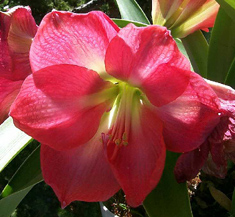 There are two kinds of people in the world and I'm not talking Democrats and Republicans. No, this is about that odd group who are already done with their Christmas shopping.
There are two kinds of people in the world and I'm not talking Democrats and Republicans. No, this is about that odd group who are already done with their Christmas shopping.I don't want to be too critical of them (on the off chance I'm on their gift-giving list!) But, as I trudge up the hill from my mailbox, each day, I can't help but grumble at the weight of my load.
I'm up to my eyeballs in holiday catalogs! Glossy color photos and deferred payments ('til February!) has, in no way, inspired me to start shopping. It's too early. I'll worry about that in December.
What I am worried about is something that probably hasn't occurred to you, or anyone else of sound mind.
It's time to get your Amaryllis growing!
Second only to Poinsettias, these big gorgeous flowers make absolutely breathtaking holiday centerpieces. Popular gifts for flower lovers (like me!)
The only problem is, they're sold in bulb form and most take 4-6 weeks to bloom. So, buy them now. That way, you'll have gorgeous flowers for Christmas, or Kwanzaa, or any other holiday that conveniently lands in December.
Tips:
- Plant in a heavy pot so they won't tip over. (Good quality bulbs grow to be huge plants, producing multiple flowers, some 6 inches wide.)
- Start bulbs in a sunny window.
- Go light on watering until flower stalk begins to grow.
- Keep soil moist while plant is growing and blooming.
- Rotate pot, exposing all sides to the sun. That way the stalk will grow straight vs. leaning toward the window.
That depends entirely on how much you like your friends. The best quality bulbs come from Jackson and Perkins. Walmart sells lower quality bulbs for 5 bucks. Jane gave me these beauties last year (photo below). I doubt they were from Wally World. Five weeks of happy blooms!
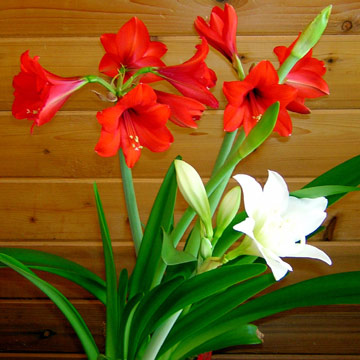
Sunday, November 12, 2006
Allium Species Bulbs
My garden is my gym, my playground and my church. It also serves as a wildlife sanctuary, a bird aviary and a butterfly brothel. But, as of today, it's closed for the season.
Great timing! On the last good gardening day I'll see for six months, my Allium Bulbs arrived! I had just finished planting them when snowflakes began to fly.
arrived! I had just finished planting them when snowflakes began to fly.
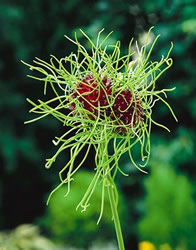 Allium 'Hair' (above) is just like it sounds. These odd, hairy flowers are a real attention-grabber in the spring garden. Bloom time is about 3 weeks, 24 inches tall, USDA zones 4-8.
Allium 'Hair' (above) is just like it sounds. These odd, hairy flowers are a real attention-grabber in the spring garden. Bloom time is about 3 weeks, 24 inches tall, USDA zones 4-8.
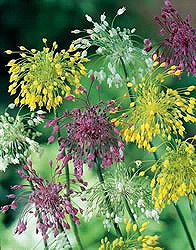 Allium 'Fireworks' (above) stand about 12 inches tall, raining bright purple, yellow and white flowers in late spring. Great for rock gardens.
Allium 'Fireworks' (above) stand about 12 inches tall, raining bright purple, yellow and white flowers in late spring. Great for rock gardens.
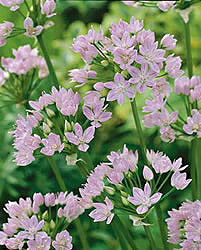 Give Allium 'Unifolium' (above) room to spread. They naturalize beautifully, creating a pretty drift of star-shaped, pink flowers.
Give Allium 'Unifolium' (above) room to spread. They naturalize beautifully, creating a pretty drift of star-shaped, pink flowers.
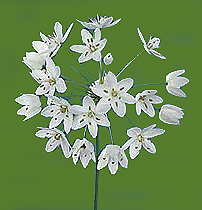 Allium 'Cowanii,' or Allium 'Neapolitanum', (above) has been around since the 18th century. These 16-inch tall, graceful bloomers naturalize quickly. Divide mature clumps in late summer, when they become overcrowded.
Allium 'Cowanii,' or Allium 'Neapolitanum', (above) has been around since the 18th century. These 16-inch tall, graceful bloomers naturalize quickly. Divide mature clumps in late summer, when they become overcrowded.
Alliums range in height from 6 inches to 4 or 5 feet, depending upon the variety. Rodents can't stand the onion fragrance of these bulbs. And, that's a good thing because this is one bulb that won't double as lunch for the pesky, little critters who patrol my garden.
They're easy to grow and particularly nice for xeric landscapes since they like dry soil, when dormant. Plant Allium 3 times as deep as each bulb is in diameter. Deep planting is important because it keeps the taller plants from drooping under the weight of the flowers.
PS: Ever been stumped on which end is up? Sometimes it's hard to tell top from bottom with strange bulbs. When in doubt, plant bulbs sideways.
Great timing! On the last good gardening day I'll see for six months, my Allium Bulbs
 Allium 'Hair' (above) is just like it sounds. These odd, hairy flowers are a real attention-grabber in the spring garden. Bloom time is about 3 weeks, 24 inches tall, USDA zones 4-8.
Allium 'Hair' (above) is just like it sounds. These odd, hairy flowers are a real attention-grabber in the spring garden. Bloom time is about 3 weeks, 24 inches tall, USDA zones 4-8. Allium 'Fireworks' (above) stand about 12 inches tall, raining bright purple, yellow and white flowers in late spring. Great for rock gardens.
Allium 'Fireworks' (above) stand about 12 inches tall, raining bright purple, yellow and white flowers in late spring. Great for rock gardens. Give Allium 'Unifolium' (above) room to spread. They naturalize beautifully, creating a pretty drift of star-shaped, pink flowers.
Give Allium 'Unifolium' (above) room to spread. They naturalize beautifully, creating a pretty drift of star-shaped, pink flowers.  Allium 'Cowanii,' or Allium 'Neapolitanum', (above) has been around since the 18th century. These 16-inch tall, graceful bloomers naturalize quickly. Divide mature clumps in late summer, when they become overcrowded.
Allium 'Cowanii,' or Allium 'Neapolitanum', (above) has been around since the 18th century. These 16-inch tall, graceful bloomers naturalize quickly. Divide mature clumps in late summer, when they become overcrowded. Alliums range in height from 6 inches to 4 or 5 feet, depending upon the variety. Rodents can't stand the onion fragrance of these bulbs. And, that's a good thing because this is one bulb that won't double as lunch for the pesky, little critters who patrol my garden.
They're easy to grow and particularly nice for xeric landscapes since they like dry soil, when dormant. Plant Allium 3 times as deep as each bulb is in diameter. Deep planting is important because it keeps the taller plants from drooping under the weight of the flowers.
PS: Ever been stumped on which end is up? Sometimes it's hard to tell top from bottom with strange bulbs. When in doubt, plant bulbs sideways.
Thursday, November 09, 2006
Haralson Apples
Crisp, juicy and slightly sour, Haralson Apples are the reason Minneapolis city slickers make a beeline to southern Minnesota for the harvest festivals.
You can take the boy out of Minnesota, but you can't take Minnesota out of our Utah boy. In late Autumn, my buddy Mike gets a care package from Mom. We're particularly nice to Mike, this time of year, because the box is filled with the most scrumptious apples you'll ever find. That is, if you can find them.
I hate to break it to Mike but when it comes to endangered species, Haralson Apples are probably on the list. They are long growing, exceptionally cold hardy apple trees, popular in Minnesota and Wisconsin and that's pretty much it. In fact, even the National Arbor Foundation couldn't tell me where I could buy one of these terrific trees.
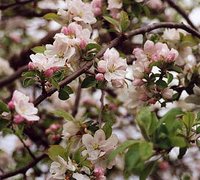 Did you know there are over 150 types of apple trees?
Did you know there are over 150 types of apple trees?Hard to believe when you view the limited variety in most supermarkets. That's because the really tasty ones don't generally hold up to the demands of trucking them all over the US.
Haralsons are disease-resistant, extremely hardy, vigorous and productive. Ideal for hard cider. If you're lucky enough to find these trees, plant 3 for easy pollination.
PS: Beautiful spring flowers, too!
Sunday, November 05, 2006
Grape Harvest in Napa Valley
 Robert Mondavi started his winery at the ripe old age of 50.
Robert Mondavi started his winery at the ripe old age of 50.I intend to follow in his footsteps, though.. tick.. tock.. tick.. tock.. I haven’t made much progress, as yet.
High altitudes are great for grape growing. Intense high mountain sunlight means more ultraviolet exposure, an ideal setting for delicious wines. Grapes mature nicely during the warm, sunny days, building sugars naturally. Cool nights improve acidity levels, vital to premium winemaking.
 Premium being the key word here because in order to get Kate’s Great Grape Escape Winery and Boutique Hotel off the ground, I’ll need to charge at least $10,000 a bottle. It’s pretty spendy to start a winery!
Premium being the key word here because in order to get Kate’s Great Grape Escape Winery and Boutique Hotel off the ground, I’ll need to charge at least $10,000 a bottle. It’s pretty spendy to start a winery!Rather than waiting for me to announce my first batch of Pinot Noir, head to Napa.Napa, like glaciers and sadly polar bears, too, won’t be around much longer, thanks to strange climactic days messing with grape production.
In the meantime, enjoy delightful Napa Valley reds and whites during harvest time when crowds are smaller and there is still lots to do.
A few fun things I've discovered on my visits to Napa:
Book a cave tour with Del Dotto Vineyards. Grab your glass and wander these haunted caves, sampling delicious reds direct from the barrels. It is, hands down, the most enjoyable wine tasting you'll ever experience. (Nicknamed Del Blotto, for generous pours and chocolate, too!)
 Reserve a room at the El Bonita Motel. This 50's style (affordable!) motel is right in the middle of Napa's popular winery road, Highway 29.
Reserve a room at the El Bonita Motel. This 50's style (affordable!) motel is right in the middle of Napa's popular winery road, Highway 29.Visit Dr. Wilkinson's (affordable!) spa for a relaxing mud or mineral bath.
Have lunch at Augerge Du Soleil (not the least bit affordable!) This incredible restaurant is located high on a hill, in Rutherford, with breathtaking views of Napa Valley.
Pick up everything you need for a gourmet picnic at the historic Oakville Grocery along the winery road, Highway 29, in Oakville. (Ten times more fun than Dean & Deluca.)
Ever wonder why they plant roses at the end of the row of grape vines? For posterity, mostly. Back before growing grapes became a science project, vintners kept a watchful eye on the roses. They'd succumb to disease quicker than grapes, alerting the grower to pests and problems before it hurt the crop.
* The highest vineyard in the world is at 9892 feet in Mendoza, Argentina. Donald Hess's first vintage, Colomé 2002, was released in October, 2006, to rave reviews.
* This darling little frog is the mascot of Schramsberg Sparkling Wine Vineyard. The frog is the only great thing they have going for them. It's a stuffy, over-priced tour, hardly worth the time and effort.
Monday, October 30, 2006
Surviving or Thriving?
 On TV, last night, an actor gave someone a cactus, claiming "You only have to water it three times a year." Hmmmm... I thought to myself. Maybe that's why cactus house plants don't grow so well.
On TV, last night, an actor gave someone a cactus, claiming "You only have to water it three times a year." Hmmmm... I thought to myself. Maybe that's why cactus house plants don't grow so well.Meet Uncle Henry - 12 feet tall, still going strong. The joke around here is that when he reaches the ceiling we'll move once again. I can't bear to part with him. As a young pup, Henry was growing 1 foot per year. Last winter, we trimmed 40 pounds off him and he's still 'overweight.'
Cactus can survive without water but they won't thrive. This one gets a drink every week and fertilizer every season. (A diluted 10-10-10 fertilizer every 3 months is perfect.) Spring for good quality cactus potting soil and some varieties will reward you with a flower or two.
This is an African Milk Tree (Euphorbia trigona). Some folks claim he's not a true cactus because of his leaves. (Experts assure me he is.)
Want an indoor tree? Buy one of these. They grow like crazy, with minimal care, in a sunny window.
Friday, October 27, 2006
Of Habits and Habitats... and Amy
 Purely by accident, I became an experimenter in the garden. I bought a flowering plant at the local nursery because it had a sign claiming it attracted butterflies. I brazenly plopped down 4 bucks. While I was planting it, a butterfly landed on my arm. Now, if that's not a sign, I don't know what is.
Purely by accident, I became an experimenter in the garden. I bought a flowering plant at the local nursery because it had a sign claiming it attracted butterflies. I brazenly plopped down 4 bucks. While I was planting it, a butterfly landed on my arm. Now, if that's not a sign, I don't know what is.Next up, a Honeysuckle. It quickly became a big monster of a vine, loaded with sweet nectar. Calliope Hummingbirds thought they'd died and gone to heaven.
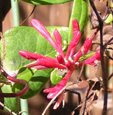 And, so, I made it a habit... building a garden that brought a different type of beauty into my world. Each summer, I worked on a habitat for butterflies, tiny hummingbirds, finches and pretty much anything else that came to call.
And, so, I made it a habit... building a garden that brought a different type of beauty into my world. Each summer, I worked on a habitat for butterflies, tiny hummingbirds, finches and pretty much anything else that came to call.Only this year, I fell short. Obligations took me far from home and I didn't really do much for my wild friends. And, that's where Amy comes in. There's a beauty to nature that's hard to define. Mostly because it's shrouded with mystery. How do butterflies find my garden? How do Hummingbirds know I've planted a picnic? I haven't exactly alerted the media to my efforts. In fact, I've told no one and, yet somehow they know and so did Amy.
 Because she marched in my door with a gift of a flowering plant known in my world as the beacon for hummingbirds!
Because she marched in my door with a gift of a flowering plant known in my world as the beacon for hummingbirds! Arizona's Hardy Fuchsia is the toughest fuchsia ever born. Known for their dainty ways, no one really expects much out of a Fuchsia, but this one can handle cold, drought and an entourage of Hummingbirds. I can't hardly wait 'til my little buddies show up next spring, wondering what's on the menu.
* Any friend kind enough to track down a Zauschneria arizonica (Hardy Fuchsia) USDA zones 5-9 is a friend for life. Pamper her, abuse the plant. It loves the rough conditions of the Southwest.
Thursday, October 26, 2006
High Altitude Bread Baking
 Winter thunder rumbles across the meadow, with snow and sleet not far behind. Such is life in the mountains, where seasons change overnight, with little warning. And, they'll change back again, tomorrow.
Winter thunder rumbles across the meadow, with snow and sleet not far behind. Such is life in the mountains, where seasons change overnight, with little warning. And, they'll change back again, tomorrow.So, I’m keeping busy baking bread. If you think high altitude gardening is a challenge, try baking a yeast bread from scratch. Dry, thin air wreaks havoc on traditional recipes and Betty Crocker is not much help. Her high altitude recipes say ‘over 3,000 feet.’ I live above 7,000 feet so, with most recipes, I'm winging it.
I’ve learned...
- Rapid rise yeast is the proverbial recipe for failure. Breads rise faster at high altitudes. I have better luck with an instant active yeast, using less than the recipe calls for.
- A little extra water helps if the dough is too dry.
Seems silly, to me, to pay $3.50 for a loaf of artisan bread when the ingredients cost about 50 cents.
Here's a yummy French Bread Recipe to try the next time you're snowed in.
Rising time: approximately 1 hour. 350 degree oven, bake for 30 minutes.
1 1/4 cups warm water
(add more water, by tablespoons, until bread dough is moist)
1 packet active dry yeast
(less 25%, if you're at high altitudes of 5,000 feet or more.)
1 tablespoon granulated sugar
1 tablespoon shortening, melted
1 1/2 teaspoons salt
3 1/2 cups flour
* Brush loaf with beaten egg for a crispier crust.
Tuesday, October 24, 2006
Live and Learn
 It didn't take long. Maybe an hour or two. By the time it was over, I learned I'd used the wrong mulch, ordered from the wrong bulb company, purchased a garden ornament from the wrong country, even the tile project was suddenly all wrong.
It didn't take long. Maybe an hour or two. By the time it was over, I learned I'd used the wrong mulch, ordered from the wrong bulb company, purchased a garden ornament from the wrong country, even the tile project was suddenly all wrong.Here I sit, polarized, wondering what to do. Finish what I started? Or, quit while I'm ahead?
Mostly I wonder what it is about me that gives others the impression I have a single digit IQ. It's as if people can't help themselves. They take one look at my blonde hair and hand me mountains and mountains of advice. The problem is... it generally stops me dead in my tracks. It's hard to move forward when you lose confidence in yourself.
I'm beginning to suspect that too much advice is worse than none at all. At least when I didn't know any better, I was making steady progress. Take last summer, for instance, when I decided to paint my house myself. People went off their rocker over that idea. I was so exasperated, I put the project on hold 'til the commotion settled down. And, guess what. My house is still not painted.
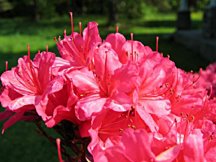 Maybe the difference between me and other people is that I don't really mind making mistakes. If nothing else, they're good for a chuckle. Plus, not everything turns out badly. When I'm successful, by my own doing, I feel fantastic. When I'm successful because I followed directions, I don't feel nearly so elated. Maybe that should hold true for lots of things - especially gardening. It's just a plant, after all. If it dies, by another one! Chances are, it wasn't your fault anyway.
Maybe the difference between me and other people is that I don't really mind making mistakes. If nothing else, they're good for a chuckle. Plus, not everything turns out badly. When I'm successful, by my own doing, I feel fantastic. When I'm successful because I followed directions, I don't feel nearly so elated. Maybe that should hold true for lots of things - especially gardening. It's just a plant, after all. If it dies, by another one! Chances are, it wasn't your fault anyway.* Take this Azalea, for instance. I planted it before I learned they don't grow here. It needs TLC but it's doing just fine. Sometimes it's fun to ignore the experts and learn new tricks all on your own.
The only real mistake is the one from which we learn nothing.
— John Powell
Saturday, October 21, 2006
Any Way the Wind Blows
 Late fall breezes put me on a collision course with haphazard balloon trips. This one bounced off the side of my house and landed in the yard.
Late fall breezes put me on a collision course with haphazard balloon trips. This one bounced off the side of my house and landed in the yard.Bailey (pup) and I have been wandering the foothills, enjoying the rustle of autumn and dreading the coming of winter. Summer went too fast. I'm not ready for hats and mittens.
And, neither is my garden. It's going out with a bang. In spite of freezing temperatures, 3 tough old gals are digging in their heels and pretending it's still summer. White Phlox (David,) Pink Evening Primrose, and Purple Salvia shake off the night's hard frost and bloom in the morning sun.
But, I can't ignore things any longer. It's time for my garden to get ready for winter. Tender perennials will be up to their eyeballs in mulch by the end of the day. I'll even break down and mow the lawn properly, cutting it short and removing the grass clippings. It will keep growing, in spite of the cold. Heavy snows can rot grass clippings if they're not removed.
On busy days, I believe whole-heartedly that you should do what you must, not all that you can. Perennials with woody stems do better if you leave them alone until spring. Their tall stems help snow drift around the plant, creating a warm blanket during cold winters. Save yourself some hard work. Leave Catmint, Iris, Gaillardia, Salvias, Lavender, Russian Sage, and Coreopsis alone until early spring.
PS: Hands off the Lilacs. They started growing next year's buds months ago, when you weren't looking. Prune them after they bloom, next spring.
Thursday, October 19, 2006
Wildflowers
 I was a bad girl, when I first moved to Utah. Mostly because I was a city slicker and I didn't know any better. Enamoured with all the pretty wildflowers, I would sometimes pick 'em on hikes in the mountains. That's a no-no. (In fact, I think it's against the law but don't turn me in - I've mended my evil ways.)
I was a bad girl, when I first moved to Utah. Mostly because I was a city slicker and I didn't know any better. Enamoured with all the pretty wildflowers, I would sometimes pick 'em on hikes in the mountains. That's a no-no. (In fact, I think it's against the law but don't turn me in - I've mended my evil ways.)Now that I'm slightly smarter, I realize that every time wildflowers are picked we hurt their chances of flourishing in their native environment.
So, I'm hot for wildflowers and I want to plant them in the ugly half of my backyard. But, where do the nurseries get their wildflower seeds? If they're harvesting them from open lands, aren't they just as bad, or worse, than me?
I had a devil of a time finding a company that seemed trustworthy. Wildflower Farm was the only one that clearly stated their wildflowers were nursery grown, not gathered from the wild.
Tips:
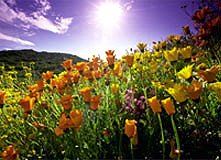
- If you order bulk seed, supplement it with quick-growing plants that will bloom first year. (I added lots of poppies to my bulk mixture because they'll bloom first summer.)
- Plant in late autumn and let nature take it's course. Remove as many weeds as you can from the garden area. Rake to loosen soil. Sprinkle seeds evenly right before a rain.
* There may be other reputable companies. If you've had good luck with some, please let me know.
Wednesday, October 18, 2006
Dis-Obedient Plant
 After the first hard frost, spiders sneak into the house, looking for a warm place to stay. It's this time of year when ski bums start crawling out of the woodwork, too.
After the first hard frost, spiders sneak into the house, looking for a warm place to stay. It's this time of year when ski bums start crawling out of the woodwork, too.Sorry to hear your Mom died. Hey, I bought a new car and I'm coming to visit for New Years!
Good grief... That was the note I received from my ex-boyfriend. On my birthday, no less. I sometimes wonder how such cold, crappy people infiltrate my life, though I know I must somehow be to blame.
Plants remind me of people and the Obedient Plant is a lot like him. Tall and charming, with snowy white flowers... and such mean-spirited behavior he'll suck the life right out of you.
This plant is so disobedient it was recently banned from sale in Utah. It's invasive, a voracious feeder that depletes soil nutrients all too quickly. If that’s not reason enough to dump this fellow, he also bullies the nice guys flowering nearby.
Now is a good time to dig up the Obedient Plant's underground rhizomes (aka big fat roots) or they'll choke neighboring perennials, come spring.
Awhile back, a popular bumper sticker bemoaned the bleeding obvious: Mean People Suck. No argument there, just curiosity. How to deal with them? Having been raised by wolves, I'm never quite sure.
* The Obedient Plant got it's name because when you bend the flower stalk, it will stay that way. 'Miss Manners' is one cultivar that tends to behave. USDA zones 4-8. Divide every 3 years.
** Try substituting White Veronica for the Obedient Plant. Veronica is not as showy but you’ll learn to love it’s low-maintenance ways.
Monday, October 16, 2006
Spooky Gulch
Home from a desert camping trip, spirits high, in spite of a drenching rain that sent us scurrying out of these wild lands before muddy roads became impassable. I tried my luck at wiggling through this 12-inch-wide slot canyon, until claustrophobic feelings, or perhaps my love of French Fries, sent me back to wider paths.
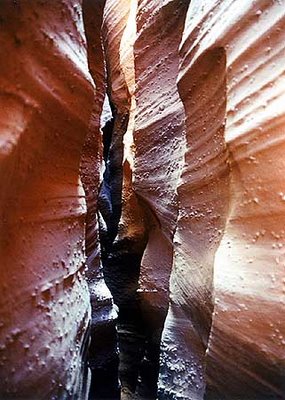 I'm in awe of desert flowers. At their will to live in spite of deadly heat and months of drought. When it does rain, they practically drown in the flash flooding.
I'm in awe of desert flowers. At their will to live in spite of deadly heat and months of drought. When it does rain, they practically drown in the flash flooding.
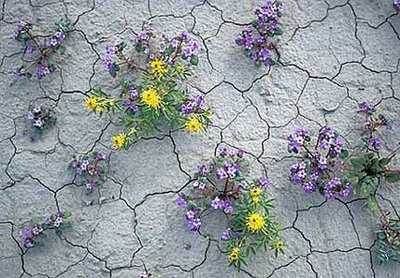 I nurture my native plants, they bloom, but not so well. Ah ha! I think to myself, as we punch it into 4-wheel drive and maneuver through the mud... Perhaps I'm killing them with kindness.
I nurture my native plants, they bloom, but not so well. Ah ha! I think to myself, as we punch it into 4-wheel drive and maneuver through the mud... Perhaps I'm killing them with kindness.
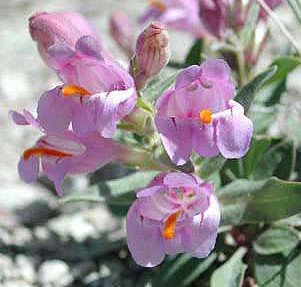 * Graham's Penstemon (above) is in current legislation to be added to the endangered wildflower list. Fall in love with the desert, but tread lightly. And, please don't pick the flowers.
* Graham's Penstemon (above) is in current legislation to be added to the endangered wildflower list. Fall in love with the desert, but tread lightly. And, please don't pick the flowers.
 I'm in awe of desert flowers. At their will to live in spite of deadly heat and months of drought. When it does rain, they practically drown in the flash flooding.
I'm in awe of desert flowers. At their will to live in spite of deadly heat and months of drought. When it does rain, they practically drown in the flash flooding. I nurture my native plants, they bloom, but not so well. Ah ha! I think to myself, as we punch it into 4-wheel drive and maneuver through the mud... Perhaps I'm killing them with kindness.
I nurture my native plants, they bloom, but not so well. Ah ha! I think to myself, as we punch it into 4-wheel drive and maneuver through the mud... Perhaps I'm killing them with kindness. * Graham's Penstemon (above) is in current legislation to be added to the endangered wildflower list. Fall in love with the desert, but tread lightly. And, please don't pick the flowers.
* Graham's Penstemon (above) is in current legislation to be added to the endangered wildflower list. Fall in love with the desert, but tread lightly. And, please don't pick the flowers.
Friday, October 13, 2006
Witch Hazel
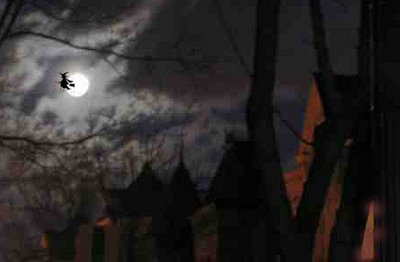 A cold wind whips along the avenue, scattering dead leaves and stirring up trouble. Dark clouds drift across a pale moon. And, all that once bloomed is done for the season. Or, is it?
A cold wind whips along the avenue, scattering dead leaves and stirring up trouble. Dark clouds drift across a pale moon. And, all that once bloomed is done for the season. Or, is it?A bit of odd magic is brewing... from one strange creature, just getting started.
Witch Hazel is a peculiar shrub, flowering in the dead of winter. It begins with brilliant autumn foliage during late fall. Come January, crooked, twisted branches burst forth with spidery, yellow blooms.
A good spell was cast upon this odd fellow, back in the Middle Ages. Witch Hazel limbs are used to divine - to find underground water - where conventional technology cannot.
 While it can't be explained, other than to acknowledge that it's true,* diviners find water with amazing accuracy, where random drilling has little success.
While it can't be explained, other than to acknowledge that it's true,* diviners find water with amazing accuracy, where random drilling has little success.Witch's Brew: Tannins and volatile oils in Witch Hazel make an effective natural astringent for treating eczema.
American Witch Hazel provides lively color in the dead of winter, when nothing normal should be blooming. Plant it in a shady spot, keeping in mind that any self-respecting shade trees will have given up the ghost when this bewitched little bush hits its stride. Hardy to USDA zone 3.
* Journal of Scientific Exploration, Stanford University, March 1995. Researchers observed two thousand divining cases prior to well-digging. The success rate of diviners in Sri Lankha was 96 percent. They predicted water depth with "amazing accuracy." Nearly all cases occurred on lands where random drilling for water had little to no success.
Tuesday, October 10, 2006
Hot Under the Collar
I was poking around the Community Center kitchen, last night, in search of disposable cups. They were showing that movie, An Inconvenient Truth.* Here I am, looking for another way to pollute the environment.
This movie is great, though I have a big gripe. You walk out of there feeling too small to make a difference. And, that's really too bad. Because nothing stops people from trying faster than that feeling of hopelessness. I'm doing a couple simple things, quite by accident, that are good for the environment. Maybe you can, too.
 I buy fresh food.
I buy fresh food.
Mostly I do that because I worked in the food industry for many years and I know what goes into that crap. Frozen food requires 10 times more energy to produce and it's not a very healthy choice.
I buy organic, including wine, whenever I can afford it.
Organic gets a bad rap because people don't understand. They think of it as some silly hippy thing. It's not. Organic soils capture and store carbon dioxide at much higher levels than soils of conventional farms.
Try this on for size: if Iowa would grow their corn organically, we’d remove 200 billion pounds of carbon dioxide from the atmosphere.
Want to make a difference? America worships the Almighty Dollar. When you buy fresh, over frozen, you impact profits in a big, big way. Food companies will change, in hopes of hanging onto your money.
You've got more power than you think. Okay, I'll get down off my soap box, now.
* The movie, Inconvenient Truth (Al Gore,) should be required viewing every April 22nd (Earth Day.) Explores the impacts of global warming.
This movie is great, though I have a big gripe. You walk out of there feeling too small to make a difference. And, that's really too bad. Because nothing stops people from trying faster than that feeling of hopelessness. I'm doing a couple simple things, quite by accident, that are good for the environment. Maybe you can, too.
 I buy fresh food.
I buy fresh food.Mostly I do that because I worked in the food industry for many years and I know what goes into that crap. Frozen food requires 10 times more energy to produce and it's not a very healthy choice.
I buy organic, including wine, whenever I can afford it.
Organic gets a bad rap because people don't understand. They think of it as some silly hippy thing. It's not. Organic soils capture and store carbon dioxide at much higher levels than soils of conventional farms.
Try this on for size: if Iowa would grow their corn organically, we’d remove 200 billion pounds of carbon dioxide from the atmosphere.
Want to make a difference? America worships the Almighty Dollar. When you buy fresh, over frozen, you impact profits in a big, big way. Food companies will change, in hopes of hanging onto your money.
You've got more power than you think. Okay, I'll get down off my soap box, now.
* The movie, Inconvenient Truth (Al Gore,) should be required viewing every April 22nd (Earth Day.) Explores the impacts of global warming.
Saturday, October 07, 2006
Odd Bulbs
Okay, I'll admit it. I watch the Sci-Fi Channel. I read News of the Weird. And, I think Jon Stewart does a better job of covering today's top stories than Katie Couric ever could.
My tastes may not match yours but, if you've got $77 dollars* and an open mind, I can turn your garden into a head-turning, jaw-dropping, talk of the town, spring blooming extravaganza.
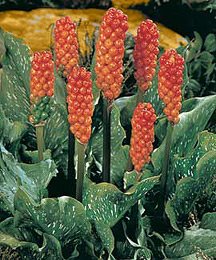 Arum Italicum: (Above) Bright orange, seedy things.
Arum Italicum: (Above) Bright orange, seedy things.
(I know nothing about this flower but I ordered it anyway.)
 Gladiator Allium: (Above) My all-time favorite!
Gladiator Allium: (Above) My all-time favorite!
Sturdy, 4-5 feet tall stems support stunning 6-inch purple flower globes!
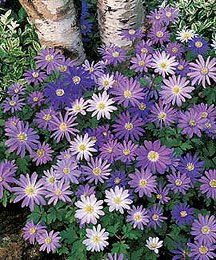 Grecian Windflowers: (Above) Tough as nails itty bitty (2 inch) daisies create a spring carpet of cheery color.
Grecian Windflowers: (Above) Tough as nails itty bitty (2 inch) daisies create a spring carpet of cheery color.
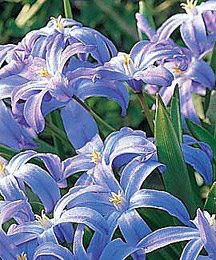 Glory of the Snow: (Above) Brilliant Lily-like blooms peek out through melting snowdrifts. Multiple flowers, naturalizes beautifully.
Glory of the Snow: (Above) Brilliant Lily-like blooms peek out through melting snowdrifts. Multiple flowers, naturalizes beautifully.
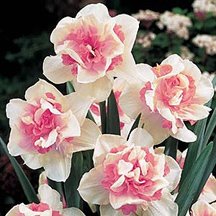 Replete Daffodils - masquerading as magnificent tulips.
Replete Daffodils - masquerading as magnificent tulips.
My tastes may not match yours but, if you've got $77 dollars* and an open mind, I can turn your garden into a head-turning, jaw-dropping, talk of the town, spring blooming extravaganza.
There's a big, wide world of bulbs out there.
And, I ain't talkin' tulips.
And, I ain't talkin' tulips.
 Arum Italicum: (Above) Bright orange, seedy things.
Arum Italicum: (Above) Bright orange, seedy things.(I know nothing about this flower but I ordered it anyway.)
 Gladiator Allium: (Above) My all-time favorite!
Gladiator Allium: (Above) My all-time favorite!Sturdy, 4-5 feet tall stems support stunning 6-inch purple flower globes!
 Grecian Windflowers: (Above) Tough as nails itty bitty (2 inch) daisies create a spring carpet of cheery color.
Grecian Windflowers: (Above) Tough as nails itty bitty (2 inch) daisies create a spring carpet of cheery color. Glory of the Snow: (Above) Brilliant Lily-like blooms peek out through melting snowdrifts. Multiple flowers, naturalizes beautifully.
Glory of the Snow: (Above) Brilliant Lily-like blooms peek out through melting snowdrifts. Multiple flowers, naturalizes beautifully. Replete Daffodils - masquerading as magnificent tulips.
Replete Daffodils - masquerading as magnificent tulips.* This is my spring bulb order. Total with shipping was $77.00, for 81 bulbs. Unusual flowers is a great reason to experiment with bulbs. Ranking a close second is how darn cheap they are, in comparison to purchasing the pre-grown perennials.
* All fall planted/spring blooming bulbs, zones 5-9 (or colder,) deer and rodent resistant. Most full sun.
* If you're an odd ball, experiment with odd bulbs. But DON'T buy them from Dutch Gardens. They take 3-4 weeks to mail your bulbs because they outsource leftovers, or lower quality bulbs, from a variety of off-price dealers.
* All fall planted/spring blooming bulbs, zones 5-9 (or colder,) deer and rodent resistant. Most full sun.
* If you're an odd ball, experiment with odd bulbs. But DON'T buy them from Dutch Gardens. They take 3-4 weeks to mail your bulbs because they outsource leftovers, or lower quality bulbs, from a variety of off-price dealers.
Subscribe to:
Posts (Atom)




